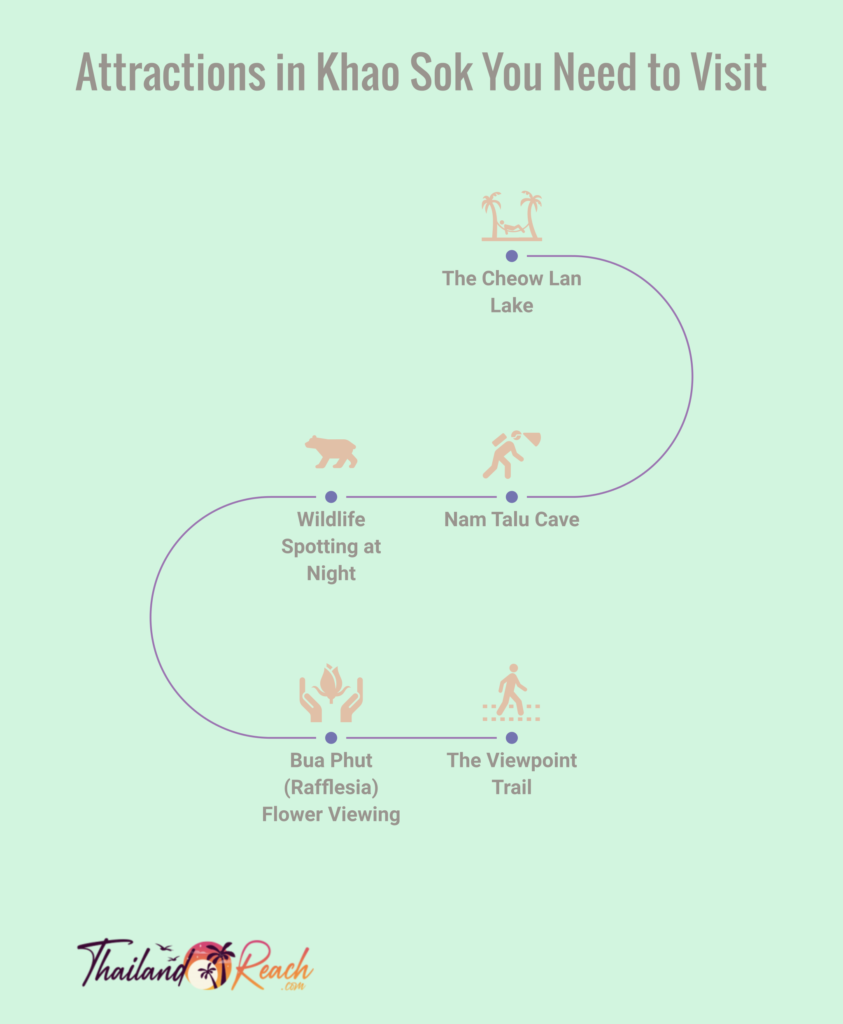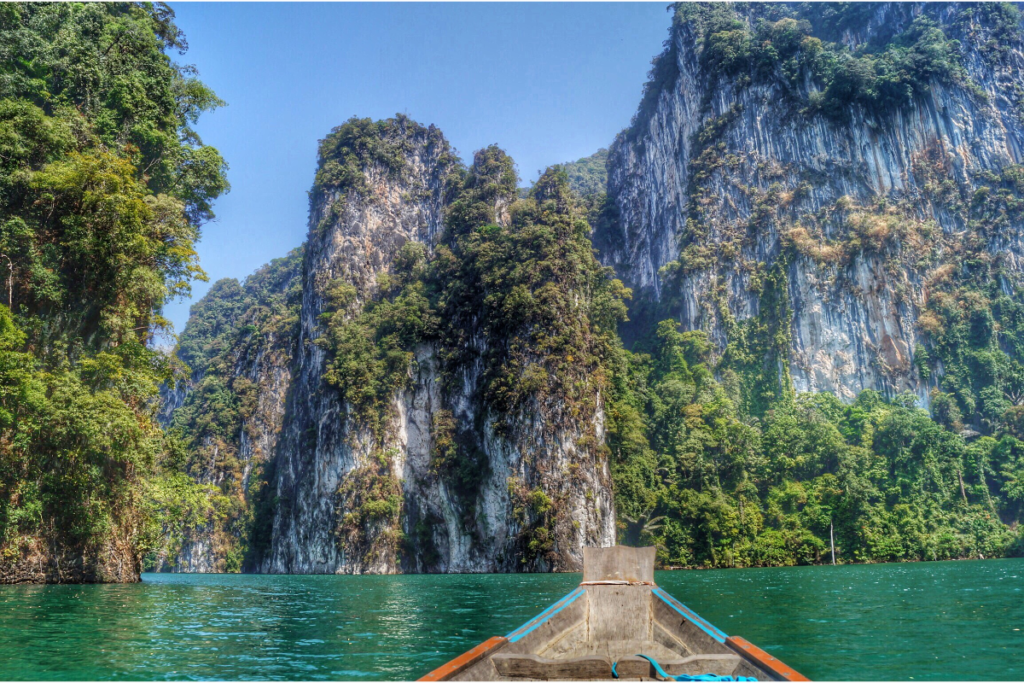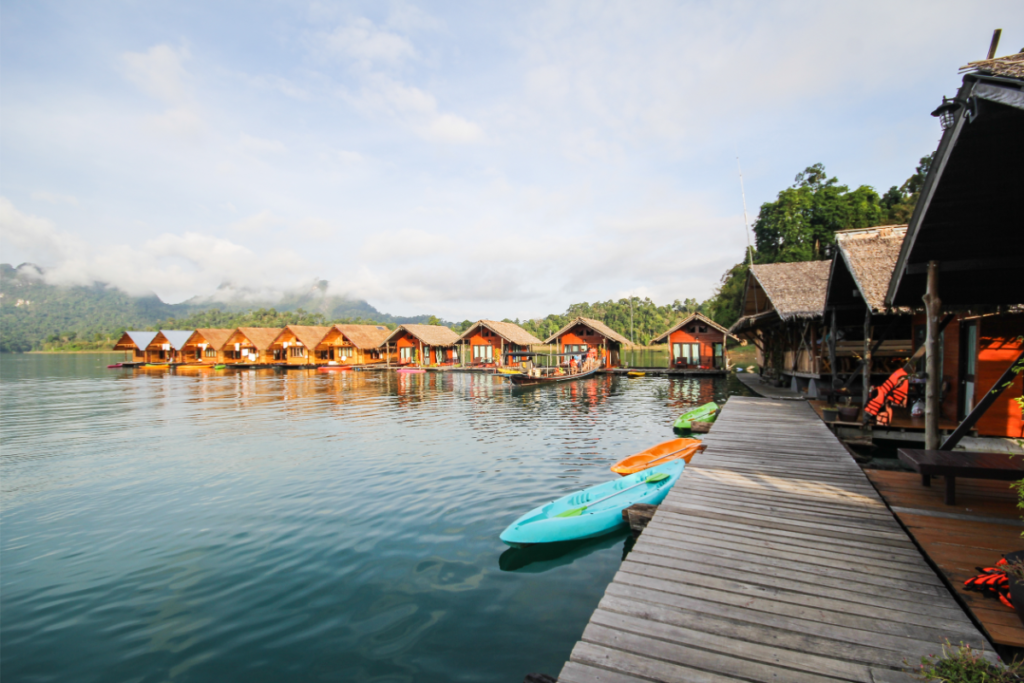Is it worth going to Khao Sok National Park? As someone who’s seen this natural marvel, I can say it’s worth the trip. The Khao Sok National Park is not merely a tourist attraction. It’s a paradise for nature lovers. Its vast biodiversity, breathtaking scenery, and exhilarating adventures make it appealing, from canoeing along peaceful rivers to hiking through deep jungle safari.
This complete guide explores the National Park’s heart. We’ll discover its fascinating history and geology, stunning animals, and many attractions that set it apart in a nation known for its natural beauty. We’ll also cover practical parts of organizing your travel, such as how to maximize your stay.
Where is Khao Sok National Park?

Let’s take a step back in time to the reign of King Rama II. This period marked the first recorded human habitation in Khao Sok, resulting from locals seeking refuge from the Burmese attacks on southwestern coastal towns. Fast forward to modern times, and Khao Sok has evolved into a sanctuary of natural splendor and cultural heritage.
Officially established as Thailand’s 22nd national park in 1980, Khao Sok has grown to cover an impressive 739 km2. But it’s not just the size that’s impressive. It’s the remarkable diversity contained within these boundaries. The park is nestled in the southern Thailand, forming an integral part of the Surat Thani Province.
Khao Sok’s geography is a veritable feast for the eyes, characterized by towering limestone monoliths, labyrinthine caves, serene lakes, and sprawling valleys. The crown jewel of this landscape is undoubtedly the Ratchaprapha Dam, constructed in 1982, which transformed parts of the park into a magnificent man-made lake.
But perhaps what sets Khao Sok apart is its claim to being home to the oldest evergreen rainforest in the world. Yes, you read that right – it’s even older and more diverse than the famed Amazon jungles of South America. Imagine wandering through a forest that has stood the test of time, its trees whispering stories of epochs gone by.
🌳A Serenade to Khao Sok’s Flora and Fauna
In this National Park, every turn of your head every step you take, is a new encounter with Mother Nature’s masterpieces. The park’s lush vegetation is a rich tapestry of over 200 floral species per hectare.
Imagine walking through the verdant foliage under the towering shadow of the Banyan trees and the elegant poise of the bamboo orchids. Perhaps, if you’re lucky, you’ll even chance upon the rare Rafflesia kerrii, the world’s largest flower, which blooms in these woods.
However, it’s not just the flora that steals the show. Khao Sok is a sanctuary for a myriad of wildlife. The park teems with life, from the agile langurs swinging through the tree canopies to the stealthy Malayan sun bears foraging in the undergrowth.
You may catch a glimpse of the majestic Asian elephant or hear the haunting call of the Great Argus pheasant echoing through the forest. The park is also home to the elusive Indochinese tiger, though spotting one would require a hefty dose of luck.
🌳Must-See Attractions in Khao Sok
Some attractions offer a unique perspective of the National Park, adding to the rich tapestry of experiences that make this natural wonder an unforgettable journey.
🌿The Cheow Lan Lake
This sprawling man-made lake, born out of the Ratchaprapha Dam construction, offers breathtaking vistas of limestone karsts rising from emerald waters. It’s an ideal spot for going on a lake tour, canoe trip, swimming, or simply soaking in the serene beauty.
🌿Nam Talu Cave
For the more adventurous spirits, a trek through this amazing cave promises an exhilarating experience. Traverse the cave’s narrow passageways, wade through waist-high waters, and marvel at the stunning rock formations.
🌿Wildlife Spotting at Night
Experience the park in a new light! Join a night safari and explore Khao Sok jungle under the starlit sky. Listen to the nocturnal symphony of the jungle, spot glowing eyes in the dark, and discover the park’s nightlife.
🌿Bua Phut (Rafflesia) Flower Viewing
If you’re visiting between December and March, don’t miss the chance to see the world’s largest flower, the Rafflesia kerrii, in bloom. It’s a rare sight that is sure to leave you in awe.
🌿The Viewpoint Trail
For panoramic views of the park, hike up the Viewpoint Trail. The trek might be challenging, but the reward at the top, with sweeping vistas of the rainforest and the distant limestone cliffs, is indescribably beautiful.
Is it Worth Going to Khao Sok National Park?

Now that we’ve explored the wonders of this National Park in Thailand, let’s address the elephant in the room – is this national park worth visiting? After all, it’s a question that warrants an in-depth answer, considering the time, effort, and resources one may invest in such a trip.
So, let’s delve into this discussion and weigh the pros and cons to help you make an informed decision.
✅The Upsides of Traveling Khao Sok National Park
Every journey is a personal experience, and while I can’t decide for you, I can certainly share some of the many reasons why this national park has enchanted countless travelers, including myself.
✔Breathtaking Natural Beauty
The park’s landscapes are a visual symphony, with towering limestone cliffs, verdant rainforests, serene lakes, and stunning caves. Every vista is a postcard-perfect frame, a testament to nature’s artistic prowess.
✔Rich Wildlife
Khao Sok is a wildlife enthusiast’s dream come true. From elusive tigers to agile langurs, from majestic elephants to vibrant birds, the park offers many opportunities to observe and appreciate diverse fauna.
✔Adventure Galore
Whether you’re an adrenaline junkie or a serene wanderer, Khao Sok has something for everyone. Explore the labyrinthine caves, paddle through the tranquil waters of Cheow Lan Lake, or hike up the challenging trails for panoramic views of the park.
✔Cultural Immersion
While the natural splendors steal the show, don’t overlook the cultural aspects of your visit. Interact with the local communities, learn about their traditions and customs, and perhaps even try traditional cooking!
✔Unique Accommodation Options
Imagine waking up to the sounds of the jungle in a floating bungalow on the Cheow Lake or spending the night in a treehouse surrounded by the lush canopy. Unique accommodation options add an extra layer of charm to your Khao Sok experience.
❎Potential Drawbacks of Visiting Khao Sok National Park
Just as there are countless reasons to fall in love with this national park, there are a few considerations that might pause some travellers. It’s important to acknowledge these potential drawbacks to provide a balanced perspective.
❌Unpredictable Weather: Khao Sok’s tropical monsoon climate means it experiences heavy rainfall, particularly between May and November. While the rain lends a fresh vibrancy to the park, it can also disrupt outdoor activities and make certain trails slippery and challenging.
❌The Crowds: As one of Thailand’s most popular national parks, Khao Sok can get quite crowded, especially during peak tourist season (December to April). If solitude is what you seek, the presence of other tourists might detract from your experience.
❌Limited Amenities: While the park does offer accommodation and dining options, they might not meet everyone’s standards or preferences. For instance, some accommodations are rustic and may lack certain modern amenities.
❌Potential Wildlife Encounters: While the opportunity to observe wildlife in its natural habitat is a significant draw for many, it’s important to remember that these are wild animals. Encounters, though rare, can be potentially dangerous if you don’t exercise caution.
❌Insect Nuisance: Being a tropical rainforest, Khao Sok is home to various insects, including mosquitoes. Make sure to pack insect repellent and wear appropriate clothing to avoid bites.
👉🏻Comparison with Other National Parks
To help you decide whether Khao Sok should be your destination of choice, let’s draw a comparison with some other notable parks in these countries like Khlong Sok National Park.
Let’s start with Doi Inthanon National Park in Thailand. Often referred to as “The Roof of Thailand,” this park is home to the country’s highest peak. While Khao Sok enthralls with its dense rainforests and stunning limestone formations, Doi Inthanon dazzles with its mountainous terrains, cascading waterfalls, and cooler climate. The park is also known for its beautiful rhododendron blooms – a sight that Khao Sok can’t offer.
Heading over to the Philippines, we have the Tubbataha Reefs Natural Park. This marine protected area in the Sulu Sea is a UNESCO World Heritage site and a paradise for divers, teeming with coral reefs and diverse marine life. Again, if underwater exploration is your preference, Tubbataha might be a more suitable choice over Khao Sok.
Next, we have Similan Islands National Park, also in Thailand. This marine park is renowned for its incredible underwater biodiversity and pristine beaches. If your interest leans toward snorkeling or diving, you might find Similan Islands more appealing than Khao Sok. However, if jungle trekking and wildlife spotting are what you’re after, Khao Sok would be a better fit.
Moreover, there’s Mount Apo Natural Park in the Philippines. As the country’s highest peak, Mount Apo offers challenging treks, stunning vistas, and a chance to witness the Philippine Eagle in its natural habitat. If mountain climbing and bird watching are your passions, Mount Apo could be an exciting alternative to Khao Sok.
How to Get to Khao Sok National Park

Now that we’ve examined the pros and cons of traveling Khao Sok, you’re likely wondering how to plan your trip. Here are some travel tips to help you make the most of your visit:
🛺Transportation Options and Directions to Khao Sok National Park
Embarking on a road trip to Khao Sok National Park is an adventure, given the variety of transportation options available. If you’re coming from Bangkok, you have three airport options – Surat Thani, Krabi, and Phuket, with Surat Thani being the closest.
You can catch a local bus or minibus from these airports to Khao Sok, which takes approximately two hours from Surat Thani and Krabi and about three hours from Phuket.
If your journey starts from the southern islands like Koh Samui, a boat trip to the mainland at Donsak pier is your first move. From there, you can arrange further transfers by minibus or coach to Khao Sok. Alternatively, shared transport services are readily available if you’re in Phuket, Krabi, or Koh Lak.
To visit Cheow Larn Lake, located within the park, you can take a taxi from the village of Ban Ta Khun to the pier, which is around 20 minutes away. Please be aware that local transport does not directly run to Khao Sok village, so arranging transport from nearby towns is necessary.
🏘Accommodations in and Around Khao Sok National Park
Accommodation varies widely, offering something for every taste and budget. Upon arriving, you need to pay Khao Sok National Park entrance fees of THB 300 (about $9).
One of the most unique experiences is staying overnight tour on Cheow Larn Lake in floating bungalows. Waking up to the sounds of the jungle and jumping into the Khao Sok lake for a swim from your doorstep is an experience you won’t forget.
For those who prefer staying on solid ground, numerous resorts, guesthouses, and lodges are around the park. Some accommodations offer a rustic experience, blending in with the natural surroundings, while others provide more modern amenities for those who prefer a bit of comfort in the wilderness.
🏳Tour Operators and Guides for Khao Sok National Park
The vastness and diversity of Khao Sok National Park can be overwhelming for first-time visitors. Engaging a tour operator or travel guide can ensure you make the most out of your visit. Many operators offer a range of packages, including jungle treks, cave explorations, wildlife spotting tours, and lake expeditions.
Remember to choose a reputable operator that prioritizes sustainable practices and respects local customs and wildlife. It guarantees a richer and more respectful experience and contributes to preserving this incredible national park for future generations.
Frequently Asked Questions
Q: What is the best time to visit Khao Sok National Park?
A: The best time to go to Khao Sok National Park for optimal wildlife viewing and outdoor activities is during the dry season, which runs from December to April. This period sees less rainfall, making the trails more accessible and the weather more pleasant for exploration. However, if you’re a fan of water-based activities like canoeing or rafting, the wet season, from May to October, brings higher water levels, making these activities even more exciting. Additionally, the park is lush and verdant during the rainy season due to frequent showers. Always check weather forecasts and local advisories before planning your trip.
Q: What are the most popular activities to do in the park?
A: Khao Sok National Park offers a variety of activities for nature lovers. Popular activities include trekking through the park and enjoying the view in Ton Kloi Waterfall, going through the dense jungle camp, spotting diverse wildlife, experiencing river tubing, visiting the stunning Cheow Lan Lake, and exploring fascinating caves. For bird lovers, bird watching is a chance to see rare species. Water-based activities include canoeing and bamboo rafting. If you’re an adrenaline junkie, you can experience a canopy tree top walk. Lastly, for a unique and memorable experience, consider staying overnight in Rai Floating Resort.
Q: Is it safe to stay overnight in the park?
A: It is safe to stay overnight in Khao Sok National Park. Numerous accommodations are available within the Khao Sok village, from resorts to Khao Sok floating bungalows in Cheow Lan Lake. These accommodations adhere to safety standards, and park authorities are vigilant about maintaining security. However, as with any travel, it’s always advisable to be aware of your surroundings, respect local wildlife, and follow park travel guidelines for your safety.
Q: Can you travel Khao Sok National Park on a day trip?
A: It’s possible to travel Khao Sok National Park on day trips. Many tour operators provide day tours, including jungle trekking, cave exploration, and wildlife spotting. However, consider spending a few days to fully immerse yourself in the experience and enjoy everything the park offers. It allows ample time to visit Cheow Lan Lake, engage in water-based activities, or even spend a night in a floating bungalow for a unique experience. Planning is key to ensuring you make the most out of your visit.
Q: What should I bring with me when visiting the park?
A: Packing to visit Khao Sok National Park should be strategic to accommodate the various activities and weather conditions. Essentials include comfortable hiking shoes, swimwear, lightweight clothing for trekking, and warmer layers for the night. Rain gear is a must, especially during the wet season. Don’t forget your insect repellent, sunscreen, and a hat for protection against the elements. A reusable water bottle is handy, as staying hydrated is crucial. Binoculars would enhance wildlife spotting experiences, and a waterproof case for your camera/phone might benefit water-based activities. Always remember to pack light and respect the environment by reducing plastic waste.
Conclusion
Traveling around Khao Sok is not just about ticking off another destination on your bucket list. It’s an immersive journey that enlightens and enriches, pushing the boundaries of your adventure spirit and leaving you with lifelong memories and stories to share.
Now that you know all the necessary information, it’s time to take the plunge and plan your visit to this incredible park. Remember, every journey begins with a single step, and yours might just lead you to the enchanting world of Khao Sok.
We would love to hear your thoughts and experiences. Have you visited Khao Sok National Park? What were your highlights? Or perhaps you’re planning a trip and have some questions? Feel free to leave a comment below. Your input could be valuable to others seeking their adventures at Khao Sok.
